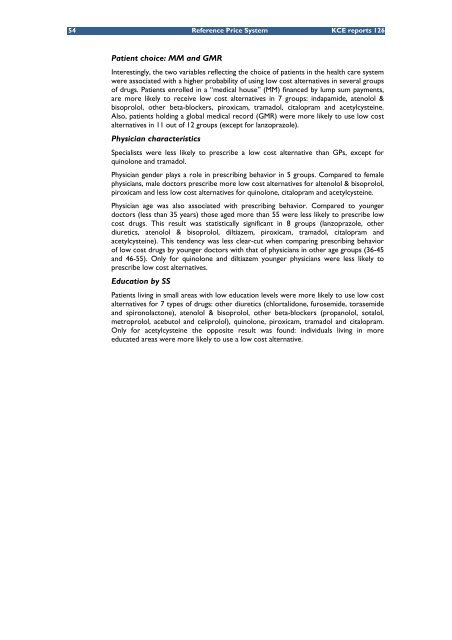The reference price system and socioeconomic differences in ... - KCE
The reference price system and socioeconomic differences in ... - KCE
The reference price system and socioeconomic differences in ... - KCE
You also want an ePaper? Increase the reach of your titles
YUMPU automatically turns print PDFs into web optimized ePapers that Google loves.
54 Reference Price System <strong>KCE</strong> reports 126<br />
Patient choice: MM <strong>and</strong> GMR<br />
Interest<strong>in</strong>gly, the two variables reflect<strong>in</strong>g the choice of patients <strong>in</strong> the health care <strong>system</strong><br />
were associated with a higher probability of us<strong>in</strong>g low cost alternatives <strong>in</strong> several groups<br />
of drugs. Patients enrolled <strong>in</strong> a “medical house” (MM) f<strong>in</strong>anced by lump sum payments,<br />
are more likely to receive low cost alternatives <strong>in</strong> 7 groups: <strong>in</strong>dapamide, atenolol &<br />
bisoprolol, other beta-blockers, piroxicam, tramadol, citalopram <strong>and</strong> acetylcyste<strong>in</strong>e.<br />
Also, patients hold<strong>in</strong>g a global medical record (GMR) were more likely to use low cost<br />
alternatives <strong>in</strong> 11 out of 12 groups (except for lanzoprazole).<br />
Physician characteristics<br />
Specialists were less likely to prescribe a low cost alternative than GPs, except for<br />
qu<strong>in</strong>olone <strong>and</strong> tramadol.<br />
Physician gender plays a role <strong>in</strong> prescrib<strong>in</strong>g behavior <strong>in</strong> 5 groups. Compared to female<br />
physicians, male doctors prescribe more low cost alternatives for altenolol & bisoprolol,<br />
piroxicam <strong>and</strong> less low cost alternatives for qu<strong>in</strong>olone, citalopram <strong>and</strong> acetylcyste<strong>in</strong>e.<br />
Physician age was also associated with prescrib<strong>in</strong>g behavior. Compared to younger<br />
doctors (less than 35 years) those aged more than 55 were less likely to prescribe low<br />
cost drugs. This result was statistically significant <strong>in</strong> 8 groups (lanzoprazole, other<br />
diuretics, atenolol & bisoprolol, diltiazem, piroxicam, tramadol, citalopram <strong>and</strong><br />
acetylcyste<strong>in</strong>e). This tendency was less clear-cut when compar<strong>in</strong>g prescrib<strong>in</strong>g behavior<br />
of low cost drugs by younger doctors with that of physicians <strong>in</strong> other age groups (36-45<br />
<strong>and</strong> 46-55). Only for qu<strong>in</strong>olone <strong>and</strong> diltiazem younger physicians were less likely to<br />
prescribe low cost alternatives.<br />
Education by SS<br />
Patients liv<strong>in</strong>g <strong>in</strong> small areas with low education levels were more likely to use low cost<br />
alternatives for 7 types of drugs: other diuretics (chlortalidone, furosemide, torasemide<br />
<strong>and</strong> spironolactone), atenolol & bisoprolol, other beta-blockers (propanolol, sotalol,<br />
metroprolol, acebutol <strong>and</strong> celiprolol), qu<strong>in</strong>olone, piroxicam, tramadol <strong>and</strong> citalopram.<br />
Only for acetylcyste<strong>in</strong>e the opposite result was found: <strong>in</strong>dividuals liv<strong>in</strong>g <strong>in</strong> more<br />
educated areas were more likely to use a low cost alternative.
















